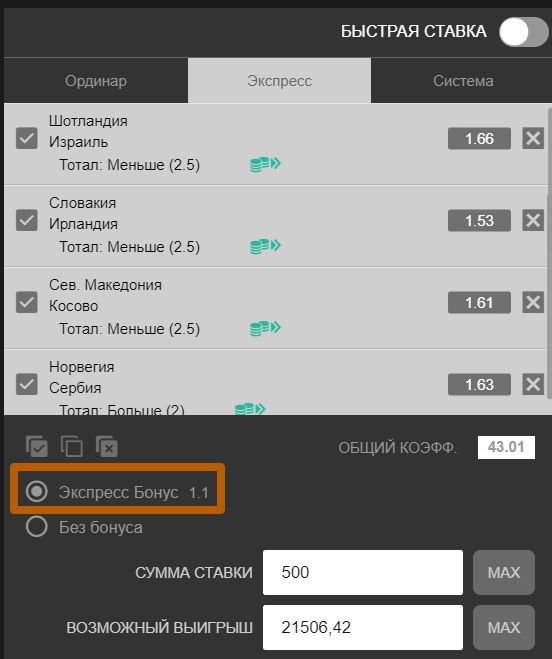Обзор БК Pin-up: дебютант с большими амбициями
В первый день октября в России начала работу новая букмекерская компания Pin-up, которая вошла в СРО «Ассоциация букмекерских контор» и принимает платежи через QIWI. Надо сказать, что БК на рынок зашла с большой помпой: обещала громкие маркетинговые акции и траты на рекламу в размере 1 миллиарда рублей в ближайший год. Пока большие амбиции вылились в приглашение Артёма Дзюбы как первого амбассадора букмекера.
Сразу после официального открытия по горячим следам была написана статья о первых впечатлениях от игры. Теперь же пришла очередь полноценного разбора конторы.
Фишки Pin-up
Стоит отдать должное компании: она подошла к делу добросовестно и предлагает качественно проработанный продукт. В этой главе речь пойдёт об особенностях сайта Pin-up. Точнее, о некоторых фишках букмекера.
Раздельные балансы: основной и бонусный
С учётом большого количества бонусных предложений Pin-up сделал классный ход, разделив бонусный счёт и основной игровой. При этом игрок постоянно видит, сколько у него денег на обоих счетах.
Главная фишка – возможность переключать счёт с бонусного на основной и обратно на усмотрение игрока.
Правда, переключение не работает, когда речь идёт о бонусе на первый депозит. Чтобы играть на бонусные деньги в этом случае, нужно иметь на основном счёте меньше 10 рублей.
Сам бонусный счёт также разделён на «фрибет» и «бонус». В первом случае ничего отыгрывать не потребуется, во втором необходимо ознакомиться с условиями отыгрыша. Обычно всё подробно расписано в разделе «Бонусы» основного верхнего меню.
Экспресс-генератор
Уникальная опция Pin-up – экспресс-генератор. Игрок устанавливает четыре параметра:
- сумма ставки;
- желаемый выигрыш;
- количество событий;
- события из линии или из live.
Система автоматически под эти критерии собирает экспресс. Игрок уже сам решает, стоит ли рисковать ставкой на предложенные события или запустить генератор ещё раз.
Идея с генератором интересная. Пожалуй, стоит добавить ещё один параметр – размер коэффициентов в экспрессе. Плюс давать в виде бонуса на такие ставки от 1 до 5%. Тогда фишка станет полноценной.
Депозит в один клик
После совершения первого депозита Pin-up предлагает в будущем делать это в один клик. В профиле игрока автоматически заполняются данные по платёжному средству, которое букмекер будет использовать при следующем пополнении баланса. Функция, как и экспресс-генератор, уникальная для рынка. Игрок нажимает на кошелёк в основном верхнем меню (опция «Депозит в один клик»), вводит желаемую сумму пополнения счёта и мгновенно получает её на баланс. Не требуется вводить никаких лишних данных, никаких кодов из СМС, ничего вообще.
Чек-редакт
Ещё одна опция, которую Pin-up предлагает своим игрокам, – «чек-редакт». Подобную услугу когда-то внедрила БК BingoBoom (сейчас BetBoom), и о ней рассказано в отдельной статье. Чек-редакт позволяет заменить одну из ставок в экспрессе другим пари с таким же или более высоким коэффициентом. Или добавить к ординару ещё несколько ставок. Опция для рынка не новая, но редкая. Полезна она или нет, судить только самим игрокам.
Приём ставок в лайве – 6 секунд
Нельзя сказать, что это какая-то особенность БК Pin-up, но не упомянуть об этом преступно. В режиме Live все ставки принимаются до 6 секунд. Это далеко не идеал, когда речь идёт о теннисе или баскетболе, но здорово, если это футбол, хоккей или другой вид спорта, где события меняются не столь стремительно. По баскетболу и теннису, к сожалению, есть претензия: лайв крайне нестабилен. Матч то пропадает с радаров, то снова появляется, ставки то доступны, то неактивны. То есть поставить на четверть прямо во время игры будет сложно. Нужно ждать перерыва.
Киберспорт – отдельная категория
Ставки на киберспорт выделены в отдельную категорию в главном верхнем меню. Скорее всего, это направление будет активно развиваться в ближайшее время. Но уже сейчас можно найти много дисциплин, есть постоянные видеотрансляции (больше на сайте нет трансляций) и ставки в режиме live.
Бонусная программа
- бонус до 30 000 рублей в виде 100% на первый депозит;
- бонусы на экспрессы;
- еженедельный Pin-up.QUIZ, позволяющий взять до 3000 рублей в виде фрибета.
Кроме того, букмекер регулярно делает другие акционные предложения. На данный момент удалось протестировать два дополнительных бонуса:
- может быть увеличен коэффициент события;
- возврат некоторой суммы от проигранного экспресса на определённые события.
В обоих случаях – никакого обмана: и котировку увеличили, и сумму от проигранного «пресса» тоже в бонусный счёт добавили.
Подробнее обо всех перманентных и временных бонусных предложениях букмекера Pin-up читайте в специальном разделе Legalbet, посвящённом бонусам. Здесь вы узнаете об условиях участия в той или иной акции, вейджерах на бонус к депозиту, подводных камнях каждого предложения. Но главное – будете в курсе всех новинок. Дадим слово эксперту Legalbet по бонусным программам Янису Плиско:
Несмотря на то что Pin-up только появился на легальном рынке, компания сразу вышла на него с несколькими интересными бонусами, время которых не ограничено, а также успела выпустить ещё несколько краткосрочных бонусов.
На данный момент Pin-up выделяется своими небольшими требованиями для участия в бонусных акциях, ни один из 5 бонусов, бывших с момента появления на легальном рынке, не требует больших вложений. Самая крупная сумма, от которой надо сделать ставку для участия, составляет 300 рублей, в остальных бонусах она ещё меньше.
Небольшая ремарка: букмекеры с такими обширными бонусными программами всегда воспринимаются крайне осторожно опытными игроками. Pin-up с его ярким дизайном сайта и самым богатым deposit-бонусом попадает под двойные подозрения.
Маржа и коэффициенты
Здесь не будем расписывать ничего подробно. Во-первых, многое было рассказано в статье о первых впечатлениях. Во-вторых, всё максимально понятно и чётко описано в обзоре букмекера Pin-up на нашем портале. Однако пара вопросов к эксперту Legalbet и работнику Арбитража Дмитрию Дёмину всё же имеется: – Pin-up предлагает низкую маржу на топ-события (футбол, баскетбол, теннис) – около 2,5-3%. Как думаешь, это предложение специально под открытие? Или мы и дальше будем наблюдать такие высокие коэффициенты? – Я могу судить только по работе офшорной версии сайта. Там на протяжении нескольких лет именно такая маржа. Одно время было даже такое, что в лайве коэффициенты давали очень высокие: на КХЛ в районе 1,95/1,95. Но потом довольно быстро они от этого отказались и пришли к нынешнему уровню. По логике можно предположить, что это регулярная цена. Но гарантий никто не даст. – Киберспорт выделен в отдельную позицию на сайте Pin-up, но имеет достаточно высокую маржу (6-8%). Это сравнимые цифры на российском рынке? Будет ли букмекер повышать котировки в этом направлении? – По киберспорту сложнее, Legalbet маржу на него пока целенаправленно не ведёт. По собственным ощущениям, особо высоких коэффициентов не даёт на рынке никто – все примерно на одном уровне. Думаю, что и в Pin-up, и по всему рынку котировки на киберспорт будут постепенно повышаться.
Служба поддержки
Служба поддержки – это лицо букмекера. По общению в онлайн-чатах игроки часто создают впечатление от компании. К сожалению, Pin-up не выдержал даже обычных тестов, хотя внешне и окошко СП выглядит привлекательно, и общаются операторы со смайликами.
Где найти сформированную заявку на вывод?
Первый вопрос к службе поддержки Pin-up возник при выводе денег со счёта. Букмекер пишет: заявка успешно создана. Однако действие не отображается ни в профиле игрока, ни где-то ещё. Служба поддержки берёт сначала 6 минут на изучение вопроса, потом ещё 7 минут. Итоговый ответ – ищите в истории операций в профиле. Но там отображаются только совершённые операции. Оказалось, что заявку на вывод следует искать в меню «Касса», через которую совершаются пополнение баланса и выплата выигрышей. Во вкладке «Вывод» находится история заявок на выплаты.
Кстати, оператор службы поддержки в итоге с этим вопросом помогла. Но прошло порядка 20 минут, когда деньги уже были выведены и в «истории операций» был отображён этот процесс. Сам вывод средств на банковскую карту занял 10 минут.
Как происходит уплата налогов?
Вопрос, который ввёл оператора в полный тупик. Изначальная версия: при выигрыше до 15 000 рублей игрок самостоятельно платит налоги. Формально ответ верный. Но тут же возникает дилемма: а что, если выигрыш больше 15 000 рублей? Ожидание ответа на этот вопрос заняло более двух суток.
К сожалению, и этот ответ назвать полноценным язык никак не повернётся. Не сказано ни про то, что 4000 рублей – это налоговая льгота, ни про то, сколько платить, если выигрыш составил более 15 000 рублей, ни про расчёт налоговой базы.
Ситуацию с налогами на самом сайте Pin-up решили просто: максимальная сумма вывода средств составляет 14 900 рублей. Так компания показывает, что игрок не может получить выигрыш более 15 000 рублей, и, соответственно, освобождает себя от бремени налогового агента.
Первые отзывы о компании Pin-up в Интернете
Две недели работы – срок небольшой, и базой отзывов на Legalbet букмекер Pin-up ещё не обзавёлся. Поэтому пришлось задействовать ещё несколько тематических ресурсов, дабы собрать хоть какую-то информацию. Голоса делятся поровну и составляют чёрно-белую общую картину. Плюсы: игроки отмечают высокие коэффициенты, большие бонусы и хорошие социальные сети (Pin-up представлен почти везде: от «ВКонтакте» до Tik Tok). Минусы: уже есть отзывы (в том числе и на Legalbet) о длительной и «ужесточённой» верификации. Игроки рассказывают, что букмекер требует новые документы для идентификации личности, как только речь заходит о выводе крупных сумм денег. Арбитраж Legalbet пока не имеет персонального контакта с букмекером Pin-up для разрешения спорных ситуаций. Активная работа в этом направлении ведётся. Надеемся, что уже скоро на портале появится официальный представитель компании.
Казино Pin up — это сервис для настоящих ценителей азарта!
Screenshosts of Colorite
Dream League Soccer 2018 First Touch Games Ltd. · Спортивные игры
If you are overweight or just want to get abs like Pinup users, then you have found exactly what you were looking for! The application — Colorite fo pinpap, has a good functionality, which contains selected exercises that will give results after the first week, a convenient and low-cost schedule that will suit everyone! Your fitness, weight loss, muscle building, calorie counting and the application «Colorite fo pinpap», this is what every user of such an application as pinup has, because they choose exactly
Don’t hope for a miracle, change your life right now by downloading the application!
Далее игрок должен сделать ставки на спорт из разделов «Линия» или «Лайв»:
1. Перейдите на зеркало pin-up, пролистайте в самый низ мобильной версии главной страницы букмекера pin-up и нажмите на кнопку c надписью и иконкой android.
Легальный букмекер Пин Ап начал свою работу в 2020 году. Владелец – компания «Уильям Хилл». Разрешительные документы № 28 выданы .
Pin-Up зеркало официального сайта Pin-Up Casino предоставляет доступ 24/7 к основному веб-ресурсу. Чтобы не заниматься поиском зеркала, лучше всего скачать мобильное приложение Pin-Up на свой смартфон. Не смотря на то, что у казино есть лицензия, доступ в некоторых странах запрещен. Ниже приведена основная информация про зеркало Pin-Up для общего представления.
2019
RECOGNITION OF EXCELLENCE
Мобильное приложение Pin Up для Android — это азартное приложение, разработанное специально для устройств на операционной системе Android. Оно позволяет играть в казино на своем смартфоне или планшете, где бы вы ни находились.
Мы выбираем вина исходя из их качества. Мы охватываем все типы вин и не боимся биодинамики, экологии или чего-либо еще, просто потому что уверены, что вино в нашей карте чистое, безупречное и высокого качества.
Букмекерская компания Pin-Up.ru объявила о ребрендинге. Теперь БК Pin-Up.ru будет носить новое название — Ivanbet. Бренд обновил не только фирменный стиль, но и формат коммуникаций с клиентами. Формально можно заявить о том, что БК Pin-Up прекращает деятельность на территории России и начинает новую жизнь под наименованием Ivanbet.
Если вы хотите делать ставки на спорт, играть в pin up casino или покер на своем мобильном устройстве, вам потребуется скачать приложение пин ап на ваш телефон. На данный момент мобильное приложение доступно только для пользователей android.
:
- Лига Ставок Пин Ап Вин
- Пин Ап Ставки Main
- Пин Ап Букмекерская Ставки На Спорт
- Пинап Ставка
- Пин Ап Ставка Fun
- Pin Up Бесплатная Ставка
- Пин Ап Ставки Отзывы Win





